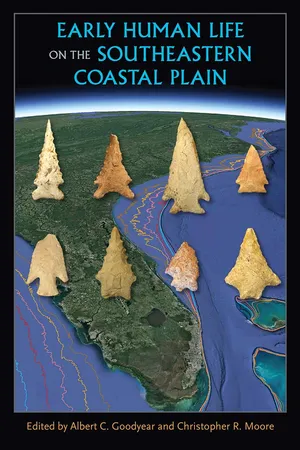
Early Human Life on the Southeastern Coastal Plain
- English
- ePUB (mobile friendly)
- Available on iOS & Android
Early Human Life on the Southeastern Coastal Plain
About this book
Bringing together major archaeological research projects from Virginia to Alabama, this volume explores the rich prehistory of the Southeastern Coastal Plain. Contributors consider how the region's warm weather, abundant water, and geography have long been optimal for the habitation of people beginning 50,000 years ago. They highlight demographic changes and cultural connections across this wide span of time and space.
New data are provided here for many sites, including evidence for human settlement before the Clovis period at the famous Topper site in South Carolina. Contributors track the progression of sea level rise that gradually submerged shorelines and landscapes, and they discuss the possibility of a comet collision that triggered the Younger Dryas cold reversion and contributed to the extinction of Pleistocene megafauna like mastodons and mammoths. Essays also examine the various stone materials used by prehistoric foragers, the location of chert quarries, and the details stone tools reveal about social interaction and mobility.
This volume synthesizes more than fifty years of research and addresses many of today's controversial questions in the archaeology of the early Southeast, such as the sudden demise of the Clovis technoculture and the recognition of the mysterious "Middle Paleoindian" period.
Contributors: Robert J. Austin | Mark J. Brooks |Christopher R. Moore | I. Randolph Daniel, Jr. | Joseph E. Wilkinson | Joseph Schuldenrein | Allen West | David K. Thulman | James K. Feathers | Terry E. Barbour II | Douglas Sain | Thomas A. Jennings | Albert C. Goodyear | Andrew H. Ivester | Dr. Malcolm A. LeCompte | Adam M. Burke | James S. Dunbar | Jon Endonino | Richard Estabrook | H. Blaine Ensor | A. Victor Adedeji | Douglas J. Kennett | Ashley M. Smallwood | Kara Bridgman Sweeney | Sam Upchurch | James P. Kennett | Wendy S. Wolbach | M. Scott Harris | Ted Bunch | David G. Anderson | C. Andrew Hemmings | James. M. Adovasio | Dr. Frank J. Vento | Dr. Anthony J. Vega
Frequently asked questions
- Essential is ideal for learners and professionals who enjoy exploring a wide range of subjects. Access the Essential Library with 800,000+ trusted titles and best-sellers across business, personal growth, and the humanities. Includes unlimited reading time and Standard Read Aloud voice.
- Complete: Perfect for advanced learners and researchers needing full, unrestricted access. Unlock 1.4M+ books across hundreds of subjects, including academic and specialized titles. The Complete Plan also includes advanced features like Premium Read Aloud and Research Assistant.
Please note we cannot support devices running on iOS 13 and Android 7 or earlier. Learn more about using the app.
Information
Table of contents
- Cover
- Title Page
- Copyright Page
- Contents
- List of Figures
- List of Tables
- Preface and Acknowledgments
- 1. Introduction
- 2. The Pre-Clovis Occupation of the Topper Site, Allendale County, South Carolina
- 3. Capps: A Levallois-Like Flaked Stone Technology in North America
- 4. The Vero Site (8IR009): Current Investigations Suggest Pleistocene Human Occupation
- 5. Paleogeography and Sea Level Positions on the Southeastern U.S. Continental Margin since the LGM: Implications to Potential Habitation Sites
- 6. The Quarry Cluster Approach to Chert Provenance: A Review of the Method with Examples from Early Florida Sites
- 7. Paleoindians in the South Carolina Coastal Plain: Tracking Pleistocene–Holocene Transitions
- 8. Brief Overview of the Younger Dryas Cosmic Impact Datum Layer 12,800 Years Ago and Its Archaeological Utility
- 9. Potential Consequences of the YDB Cosmic Impact at 12.8 kya: Climate, Humans, and Megafauna
- 10. Regional Manifestations of Late Quaternary Climate Change and Archaeological Site Burial along the South Atlantic Coastal Plain
- 11. Multiple Scales of Interaction in the Early Side-Notched Horizon
- 12. Discerning Early Archaic Bolen Territories Using Geometric Morphometrics
- 13. From the Savannah to the Santee River: Early Archaic Mobility and Raw Material Utilization in the Coastal Plain of South Carolina
- 14. Late Pleistocene/Early Holocene Archaeology of the Southeastern Atlantic Slope
- 15. Migrations and the Early Human Ecology of the Southeastern Atlantic Slope: A Long View
- References Cited
- List of Contributors
- Index